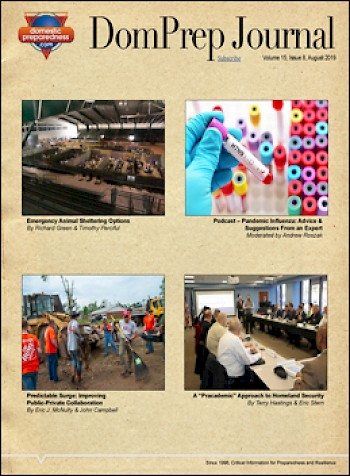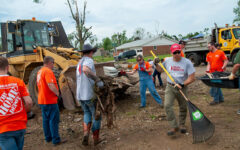

Emergency Animal Sheltering Options
Richard Green and Timothy Perciful
August 28, 2019
Article Out Loud When there is a need for sheltering animals, there are several options – each comes with advantages and disadvantages. Conditions, agency policies, experiences, resources, or timing typically

Don’t Procrastinate – Collaborate
Catherine L. Feinman
August 28, 2019
After a disaster, stories often emerge about companies and organizations that provided resources
and services to aid in the response efforts. Sometimes these are prearranged formal agreements, but
often they emerge more spontaneously as the need arises within communities. It, of course, is not
possible to plan for every potential threat or scenario. However, there are many actions that could be
taken in advance of an emergency to build resilience into any ensuing scenario.

A “Pracademic” Approach to Homeland Security
Terry Hastings and Eric Stern
August 21, 2019
It is important for academics and practitioners to collaborate and learn from each other. Academic
research can help to address real-world challenges, and practitioners are uniquely positioned to provide
meaningful insight to help shape research agendas.

Pandemic Influenza: Advice & Suggestions From an Expert
Andrew R. Roszak
August 14, 2019
With the myriad of threats that communities prepare for, influenza pandemic is consistently at the top of the priority list. In recent years, strains such as H7N9 and H1N1 have caused concern among health officials. It is no mystery why, considering the 1918 influenza pandemic – which infected over 500 million individuals around the world and caused tens of millions of deaths. Domestic Preparedness Advisor Andrew Roszak recently had the opportunity to sit down with one of the world’s leading pandemic experts, Dr. Lisa Koonin. Dr. Koonin recently retired from a 30-plus year career at the U.S. Centers for Disease Control and Prevention. She was one of the leads for pandemic influenza preparedness and response efforts.

Predictable Surge: Improving Public-Private Collaboration
Eric J. McNulty and John Campbell
August 7, 2019
Public-private collaboration in disaster preparedness and response is currently sub-optimal in its organization and operational performance. This may be due to the perception of government entities that all collaboration must be formal in nature. As a consequence, small, medium, and even large private organizations may be reluctant to become involved in preparedness planning. However, reality suggests that organizations without existing contracts or partnerships are willing to participate in response efforts. This tension effectively limits the ability to anticipate the contributions that will come from entities outside of formal partnerships. “Predictable surge” is a new framework through which public and private entities, particularly at the state and local levels, may better work together to build preparedness and foster community resilience.

